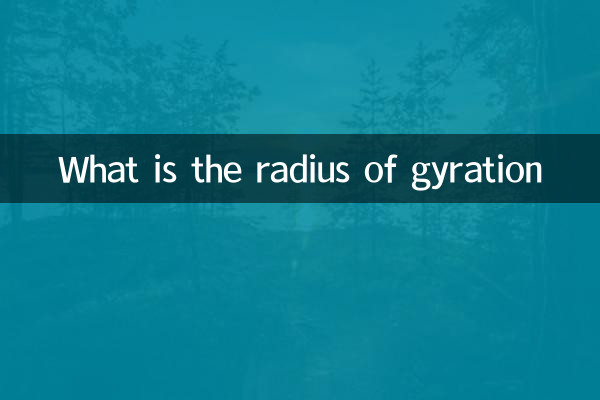What is the radius of gyration
Radius of gyration is an important concept in physics and engineering, used to describe the inertial properties of an object when it rotates around a certain axis. It is not only widely used in mechanical design, aerospace and other fields, but also a key parameter for understanding the rotational motion of objects. This article will combine the hot topics and hot content on the Internet in the past 10 days to analyze in detail the definition, calculation method and practical application of the radius of gyration.
1. Definition of radius of gyration

Radius of Gyration refers to the equivalent distance of the mass distribution of an object relative to the axis of rotation when it rotates. Simply put, it concentrates the mass of the object on an imaginary point so that the distance between the point and the axis of rotation can represent the rotational inertia of the entire object. The mathematical expression of the radius of gyration is:
k = √(I/m)
in,kis the radius of gyration,Iis the moment of inertia,mis the mass of the object.
2. Calculation method of radius of gyration
The calculation of the radius of gyration depends on the shape and mass distribution of the object. The following is the formula for calculating the radius of gyration of several common geometric shapes:
| Geometry | Radius of gyration calculation formula |
|---|---|
| Slender rod (around center) | k = L/√12 |
| Slender rod (wrapped around one end) | k = L/√3 |
| Ring (around center) | k = R |
| Disc (around center) | k = R/√2 |
| Solid ball (around diameter) | k = R√(2/5) |
3. Practical application of radius of gyration
The radius of gyration has important applications in many fields. The following are practical cases related to the radius of gyration in hot topics in the past 10 days:
1.Mechanical design: In the design of the robotic arm, the radius of gyration is used to optimize the moment of inertia of the joint, thereby improving the movement efficiency and stability of the robotic arm.
2.Aerospace: In the attitude control system of satellites and spacecrafts, the radius of gyration is a key parameter for calculating the moment of inertia, which directly affects the stability and energy consumption of the aircraft.
3.exercise science: In the design of athletes' equipment (such as golf clubs and tennis rackets), the radius of gyration determines the controllability and hitting effect of the equipment.
4.building structure: In the wind-resistant design of high-rise buildings and bridges, the radius of gyration is used to evaluate the dynamic response of the structure under wind loads.
4. The relationship between the radius of gyration and the moment of inertia
Radius of gyration and moment of inertia are two closely related concepts that describe the rotation characteristics of an object. The moment of inertia (I) is a measure of an object's resistance to change in rotational motion, while the radius of gyration (k) is the equivalent distance representation of the moment of inertia. The relationship between the two can be expressed by the following formula:
I = m * k²
This means that the larger the radius of gyration, the greater the moment of inertia of the object, and the stronger its ability to resist changes in rotational motion.
5. Summary
The radius of gyration is an important parameter that describes the rotational inertia of an object and is widely used in fields such as machinery, aviation, sports science, and architecture. By understanding the definition of the radius of gyration, its calculation method, and its relationship with the moment of inertia, you can better optimize the design and solve practical problems. I hope this article can help you gain a deeper understanding of the concept of radius of gyration and its application value.

check the details

check the details